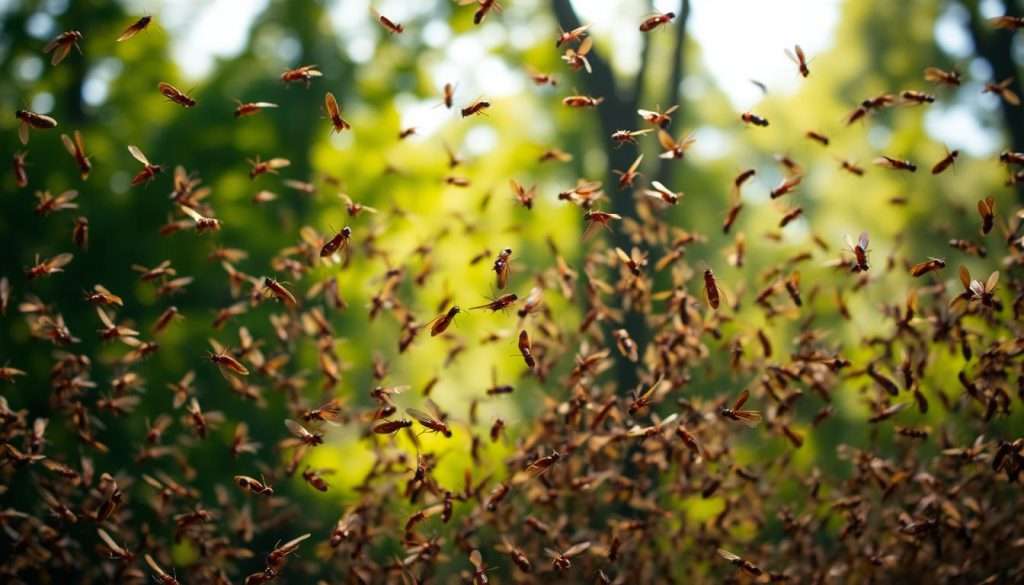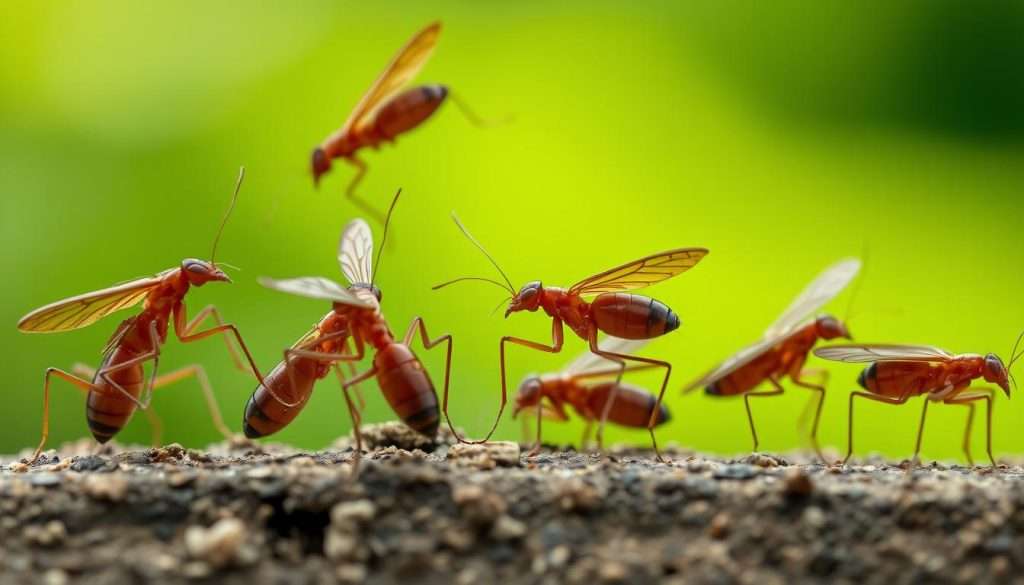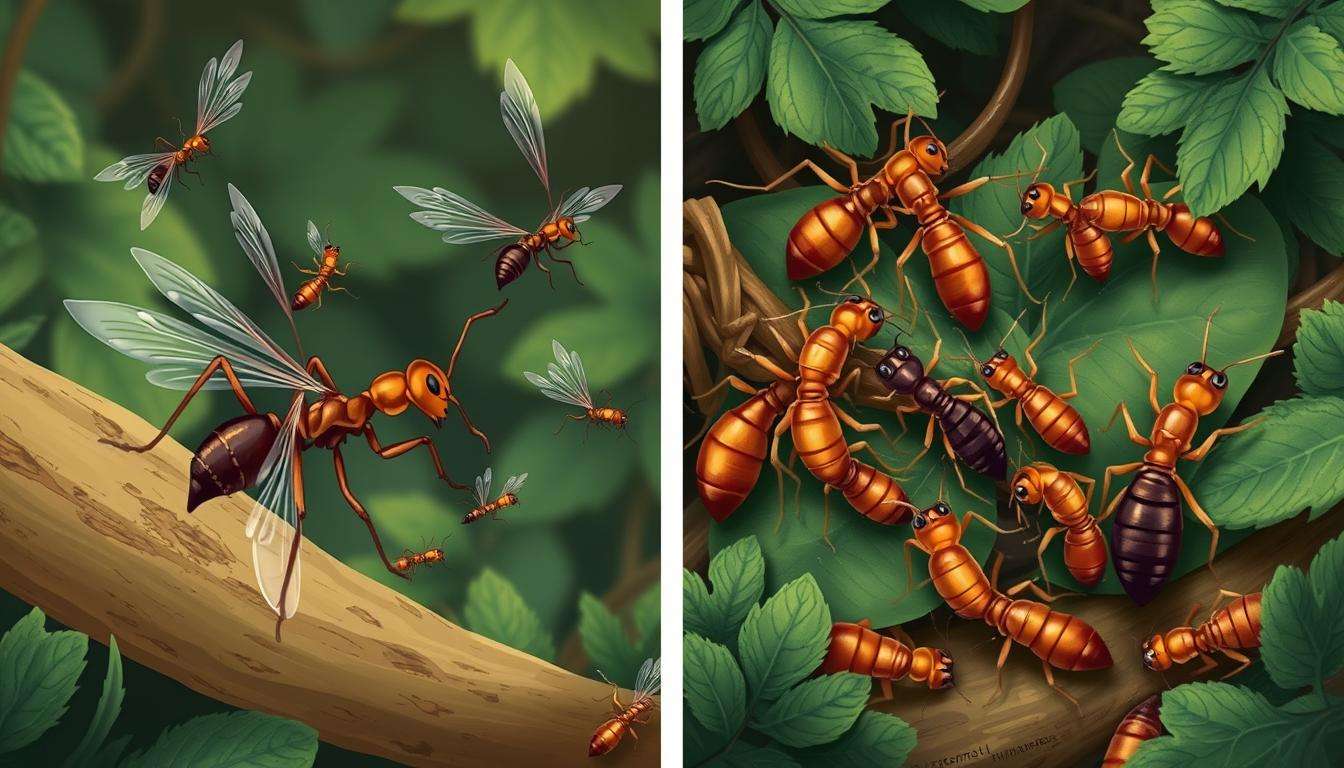Knowing the difference between flying ants and termites is key for homeowners. They look similar but act and damage differently. Flying ants, like carpenter ants, can look like termites.
Flying ants are often seen outside during mating season. Termites hide in colonies that can damage wood a lot.
Termites have a long, straight body and a long abdomen. Flying ants have a pinched waist and three body parts. Their wings are different too.
Termite wings are long and white. Flying ants have shorter, brown wings with the front ones longer. Knowing these differences helps you spot and stop infestations.
Key Takeaways
- Flying ants have a distinctive pinched waist while termites have a straight body.
- Termite wings are longer, uniform, and translucent compared to the shorter, varied wings of flying ants.
- Both species have unique swarming behaviors and seasons; flying ants swarm in summer and termites in spring.
- Identifying droppings and discarded wings can help pinpoint termite infestations.
- Consulting professionals is crucial for effective pest control and prevention.
Physical Characteristics: How to Differentiate
It’s important to know how to tell flying ants and termites apart. We can do this by looking at their body shape, wings, and antennae. These features help us tell ants from termites.
Body Structure and Shape
Flying ants have a narrow waist. This makes them look segmented. Termites, however, have a wider body that looks smoother and more uniform. This shape difference is a big clue when trying to tell ants and termites apart.
Wing Structure and Size
Wings are another key difference. Termites have wings that are the same length and are clear. Flying ants have longer front wings than back wings. These wing differences are easy to see when they swarm.
Antennae Distinctions
Antennae are also important for telling them apart. Termites have straight antennae. Flying ants have bent antennae. Looking at the antennae can quickly help you tell ants from termites.
| Characteristic | Flying Ants | Termites |
|---|---|---|
| Body Shape | Segmented, pinched waist | Broad, uniform |
| Wing Structure | Forewings longer than hindwings | Equal-length wings |
| Antennae Type | Bent | Straight |
Behavioral Differences Between Flying Ants and Termites
Learning about the behavior of flying ants and termites helps you tell them apart. Watching these insects shows different patterns in their actions and what they eat. This knowledge helps homeowners and DIY fans know how to act.
Swarming Behavior of Flying Ants
Flying ants swarm in summer, mainly to mate. They show up in big numbers for a short time. Their main goal is to find mates and start new colonies.
This behavior is a clear sign of flying ants. They don’t swarm as much as termites do.
Swarming Behavior of Termites
Termites swarm in early spring, usually. They come out when it’s warm and humid. They are attracted to light and shed their wings after finding a new home.
This means they might start new colonies, which could lead to infestations.
Feeding Habits
Flying ants and termites eat differently. Flying ants eat nectar, seeds, and other insects. Termites, on the other hand, eat wood and cellulose-based materials.
This difference shows why termites can damage buildings. Knowing this helps keep your property safe.

Are Flying Ants Termites: Spot the Key Differences
It’s important to know the difference between flying ants and termites for home care. Flying termites have unique traits that ants don’t. Spotting these differences helps homeowners act fast to prevent damage.
Key Distinctions to Note
There are clear visual and behavior differences between flying ants and termites. Here are the main differences:
- Body Structure: Ants have a narrow waist, while termites have a round body.
- Coloration: Flying ants are reddish-brown, termites are creamy white.
- Wing Structure: Ants have shorter back wings, termites have equal-sized wings.
- Feeding Habits: Carpenter ants dig into wood, termites eat the wood, causing more damage.
Understanding Swarm Seasons
Swarm seasons for flying ants and termites are different. Termites swarm in April and May, when it’s rainy. Flying ants swarm all year, especially in warm, humid places.
Knowing these times helps control pests better. Termites cause over $5 billion in damage each year in the U.S. It’s key to stop them early.

With this info, you can spot flying ants and termites during their swarm times. Early detection helps prevent damage and keeps your home safe.
Identification and Inspection for Damage
It’s key to spot flying ants or termites to keep your home safe. Knowing how to find these pests helps you act fast. This can stop more damage and save money on repairs.
Identify Signs of Flying Ants
Here’s what to look for when checking for flying ants:
- Brown wings, with front wings longer than hind wings.
- Swarming activity, especially in warm months.
- Wood shavings or debris near nests.
- Short lifespan visibility; flying ants live about 6-8 weeks.
Identify Signs of Termite Infestation
Spotting termites is vital to protect your home. Look for these signs:
- Wings of equal length, about double their body.
- Wider body shape with a straight look.
- Mud tubes or frass near wood.
- Damage to wood and structures.
How to Conduct a Thorough Inspection
Here’s how to inspect your home well:
- Check the basement and crawl spaces for signs.
- Inspect the attic and foundation often.
- Look at timber connections to the ground for entry points.
- Keep firewood, compost piles, and mulch away from your home.
Being proactive helps you fight off pests. Regular checks let you spot problems early. For more tips on pest spotting, visit this link.
Conclusion
Knowing if you have flying ants or termites is key. The ways to deal with them are different. This is important for finding the right pest control.
Termites can really damage your home. So, it’s important to know how to protect it. Regular checks and upkeep are a must for homeowners.
Watching for signs of pests is crucial. Knowing the difference between flying ants and termites helps keep your home safe. This way, you avoid expensive fixes later.
If you see signs of pests, act fast. Getting help from pest control experts is a good idea. They can tell you what you have and how to fix it.
Being informed and proactive is your best defense. It keeps your home safe from pests.
